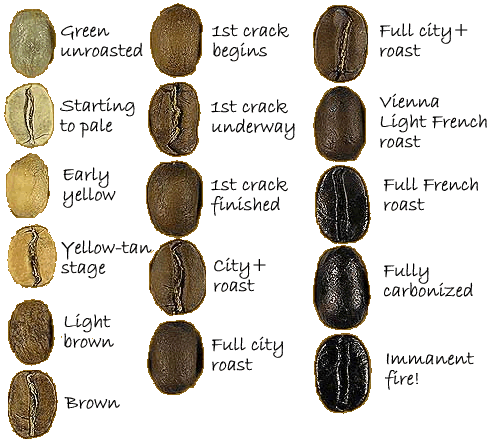


The Bean.
The Roast.
The Grind.
The Brew.
The Bean
There are 4 kinds of coffee beans in the market:
Arabica, Liberica, Excelsa, Robusta. Each has its own distinct taste and characteristics which is further enhanced based on the post harvest process done by the producer.
The beans come from coffee trees that bear "coffee cherries" and only ripe coffee cherries should be picked and processed. Post-harvest processing usually involves several steps and may take a couple of weeks before the beans are ready for either shipping or roasting.
A bag off coffee is called "single origin" when it contains 1 kind of bean variety from one region or farm.
A "blend" is a bag of beans that contains 2 or more kinds of bean varieties or origins.
The Roast

From unroasted to the different roast levels.
Roasting is a crucial step in influencing the final taste of coffee. Stop the process too early, you dont get enough of the "coffee flavour" and end up with an underdeveloped roast that may taste just "grassy" or sharp undefined acidity. Stop it too late and you will lose most of the bean origin flavour, or worse, you can be left with nothing but coffee that tastes like rubber.
For most beans, the ideal roast level is *usually* somewhere in between the 1st and 2nd crack (medium/city roasts). It's usually where the balance between acidity and body is found. The darker roasts are usually best for espresso.
People often associate dark roasted beans to stronger coffee. Truth is, light and dark roasted coffee have about the same amount of caffeine in them. Taste-wise, darker roasted beans have subdued acidity and other fruity/flowery flavours, and the chocolatey, caramel-y flavours are dominant.
The Grind
The grind size is important for proper extraction of the coffee. Different brew methods require different grind sizes and will give you slightly different flavours and body in the cup.
Coarse
French/coffee press, percolator
Medium
Drip makers with flat bottom filters
Medium/Fine
Drip makers with cone shaped filters
Fine
Espresso
Super Fine
Turkish/Ibrik
Of course, you can always experiment and adjust the grind size to find your 'perfect cup'.
Burr grinders are usually recommended to be used as they allow for different grind sizes and produce a more even grind. It is also best to grind only the amount you will use before brewing.
The Brew
In this step, you are basically extracting flavours from the coffee grounds; hence, having the correct grind size is crucial. Aside from that, the proper ratio of water to grounds AND water temperature should be taken into consideration especially if you are working with specialty grade coffee beans.
If you have a fully automated drip maker or espresso machine, you may not have to worry too much about certain parameters.
Technicalities come up when you start dong the manual brews:
-
water temperature: about 95degreesCelsius (+/-2degrees)
-
-
grind size: refer to grind guide above
-
-
ratio: a good ratio to start with is 1:15 (coffee:water) so for an 8oz cup, you can use 12-15grams of coffee grounds
Of course all these parameters can be tweaked to how you like your coffee. You can adjust the amount of water or coffee grounds. Experimentation is key to find your perfect cup.